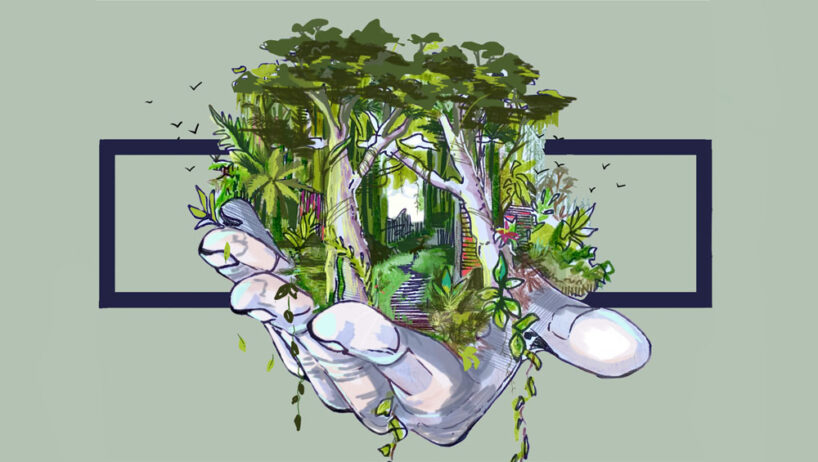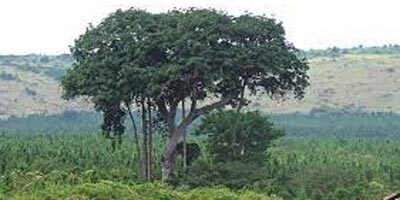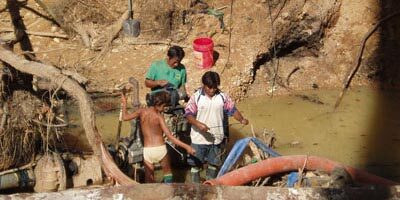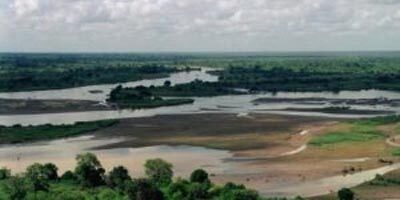[Companion podcast is also available here!]
“The Amazon for me represents hope,” says Andrea Echeverri, an environmental activist in Colombia. “We must keep our business out of conservation, we must keep profit out of human rights, and the Amazon is a great opportunity to win the struggle against disputes over conservation, disputes over human rights. So we’re going to regain the Amazon for its people, we’re going to regain the Amazon for life, we’re going to regain the Amazon for the Amazon itself. For its rivers, for its trees, for its magic.”
As the world experienced an unprecedented heat wave in the summer of 2022, response to climate change become more pressing than ever. So for the Amazon forest, the focus is mainly on its climatic function. Little attention is paid to the human rights aspect of the crisis, as indigenous people and local communities in the region face severe challenges as a result of deforestation. Also often overlooked is the role of consumers, corporations and the supply chain.
To better understand the reality and the dynamic in the forest, I spoke with three South America-based experts:
- Alejandra Zamora Rios, a forest engineer specializing in forest management issues related to forest concessions, remote sensing, creation of protected areas, and ecological zoning. She is also the Peru facilitator of the global coalition Rights + Resources, and a consultant at the Center for International Forestry Research. She was involved in analysis of historical deforestation from 1975 to 2016 in the native communities of Madre de Dios, and the Global Comparative Study on Forest Tenure Reform by the Center for International Forestry Research.
- Andrea Echeverri Sierra, who is part of Censat’s -Asociación Centro Nacional Salud, Ambiente y Trabajo (CENSAT Agua Viva), the Colombian branch of Friend of the Earth International, Jungles and Biodiversity team. Her current work focuses on carbon markets, deforestation, and real alternatives to them.
- Astrid Milena Bernal Rubio, an associate for the Unsustainable Livestock Campaign at Global Forest Coalition and a member of the Global Network for Human Rights and Environment. As an environmental lawyer, a researcher, and a campaigner, she is actively involved in various initiatives regarding climate finance and environmental justice.
What’s at stake in the Amazon?
The Amazon is a major source of revenue in Latin America. Cattle ranching and agricultural activities, such as soybean and palm oil production, require wide-open space, while extractive activities, such as oil, timber, and mining, also involve massive forest clearing. More subtly, as noted by Alejandra Zamora, is narco-trafficking. “The issue of drug trafficking, which is linked to the issue of deforestation, is also linked to the issue of palm plantations since, when drug plants are planted between the rows of palm trees, the crop is not visible through satellite images.”
The establishment of industrialized food production as a major cause of deforestation has brought irreversible change to local and indigenous livelihoods, especially the way in which extensive land-grabbing and cattle ranching threatens the old way of living. The industrialized system expanded its business over people’s ancestral land, in the meantime, taking away domestic market shares from peasant farmers, which they rely on to make a living.

“In Colombia, as well as in Brazil, there is a strong culture associated with livestock production,” Astrid Bernal said. “But the current production system is not in line with the traditional cultures and the traditional way to produce meat. Rural families and small farmers want to keep animal production, but the industrialized system is far away from what is happening in, or what is needed in the communities broadly.”
The Amazonian state governments played a rather passive role in ensuring land tenure for indigenous communities. The lack of relevant legislation has not only empowered corporations to appropriate indigenous land for industrial use but also enabled illegal activities to thrive. The absence of extraction permits spares artisanal extractors from post-extraction mitigation, which brings detrimental impacts to the environment.
Zamora offered an example in Madre de Dios, a hotspot for illegal alluvial gold mining. She told me that water and aquatic fauna, as well as farmland, are contaminated by sand and mercury from mining operations, severely threatening the health and survival of the lower watershed communities.

With conservation promoted as a solution to deforestation, it became the fashion for environmental management. However, Echeverri says that instead of providing genuine protection to the forest, the Colombian government still allows cattle ranch farms to be installed inside national parks. Meanwhile, the lack of state commitment to surveillance has enabled numerous illegal activities to take place in these areas.
In the Amazon, enormous traditional indigenous territories overlap with the range of protected areas. “The rigid conservation scheme has provoked what communities call ‘territorial dispossession’ in the name of conservation,” Zamora said. The displacement of indigenous people emerged as a prominent issue in protected areas, and coercive measures such as bomb threats and jail sentences have been used to force them out of their ancestral land.
In the Amazon, there is a strong culture deriving from nature. The concept of “forest citizenship” was identified in the 2021 report of the Science Panel for the Amazon, where it is defined as the cultural and political identity of forest inhabitants. Arbitrary administrative decisions made without respecting the intimate bond between humans and nature require more public censure, given the important cultural and spiritual role the forest plays in indigenous cultures.

As Zamora emphasized in our conversation, “It is necessary to re-emphasize the relationship between territorial violations and human rights violations. To violate the community’s territory, because of the link between the land and its identity, is to violate not only its property rights but also its right to integrity and a series of economic, social, cultural, and environmental rights.”
What’s wrong with the solutions?
Deforestation has been perceived more as an environmental crisis than a reflection of socio-cultural injustice, and the discrepancy between perception and reality has resulted in futile solutions. “All those carbon market projects only attack the weakest pieces of the chain, but they don’t take into account the roots of the problem,” Echeverri told me. “The planet is showing us in a bad way that we must change our ways, and we must recover from those things that have worked as false solutions, such as carbon market, geoengineering, and all those technological solutions that are allegedly creative but don’t question the way in which we are living in this planet right now.”
Indeed, the human right crisis the forest is experiencing should hardly be seen as a result of natural succession, but rather as a man-made tragedy that clearly points to the structural defects of society. The Amazonian countries have long been subjects to the a market-oriented exclusive development trajectory. Without respect for the culture and the agency of indigenous people and local communities, it is hard to make the right decisions. In this case, instead of acknowledging indigenous people as ancestral custodians of their territories, Zamora said, “Peru saw the jungle as a territory to be conquered, as free land to produce, without understanding the dynamics of the ecosystem and without respecting the populations that already lived there.”
While failing to understand the intimate connection between indigenous people and their land has caused problematic solutions, weak regulations on relevant industries also stimulates extractive activities. Echeverri emphasizes that, “when we talk about commodities, we must also recognize the legal stuff that is promoted by the government – its legal mining, legal cattle ranching, and legal palm oil.” The political sphere has always cleared the way for industrial expansion. However, making a difference with respect to private sector regulation can be a major challenge, considering that the drivers of deforestation are pillar industries of the Amazonian economies.
The unlimited advancement of the industrialized world remains a major threat to social justice as well. With massive funds from international financial institutions, the industrialized mode of production is further carried on by international conglomerates in Latin America. Consumers, on the other hand, are unaware of what is happening on the ground. “They don’t know that many of these animals have been confined in industrial farms, on lands that were once the property of rural communities, and many communities are being affected,” Bernal said. The large-scale food production schemes are taking place on indigenous and local farmers’ land, whereas the products are exported and the revenues are flowing to other countries. More problematically, unregistered local producers are becoming upstream providers for the bigger corporations, which adds more obstacles when it comes to origins sourcing.
The supply chain, and consumer responsibily
The greatest challenge of halting deforestation is not merely political, but cultural. While demand lasts, there is an incentive to produce. The world shares a common culture of meat consumption. According to the Food and Agriculture Organization of the UN, more than 80 billion land animals are killed for food annually. However, most consumers do not question the source of their food or the way meat is produced, let alone how their consumption pattern will affect the livelihoods of others.
Transparency and traceability are key issues in livestock production, since the way in which small producers provide for corporations may be illicit. Lack of transparency allows companies to prioritize their business interests, while the absence of a creditable tracking system deprives consumers of relevant information. The need for a more transparent supply chain is crucial, since the way in which animals are fed and growing is not only pertinent to local livelihoods but to lives in the cities as well. Consumer responsibility is often regarded as a social responsibility to other lives, but it is essentially a responsibility to our own future as well.
What’s been done?
With local environmentalists and indigenous leaders advocating for better forest governance, many policies have been put forward in the Amazonian countries. On the bright side, countries like Peru, thanks to the legislative framework such as la Ley de Consulta Previa Libre e informada (the Law of Free and Informed Prior Consultation), la Ley de Medio Ambiente (the Law of Environment), have taken more inclusive approaches. “Communities have more information and are therefore better able to access justice and carry out better political advocacy,” Zamora said. Nevertheless, the way and the degree of implementation vary greatly. Echeverri told me that in Colombia, the government and the peasant communities have reached an agreement on substituting coca plantations to halt deforestation, but the reform proceeded in a coercive manner – farmers were bombed and put into jails to cooperate, which has made it hard for farmers to accept and move on to the alternatives.
The international community has been taking an active part in protecting the Amazon forest. As one of the most powerful economies, the European Union proposed regulatory frameworks to minimize environmental and human rights impacts in trade. As I write this article, the EU is in the process of ratifying mandatory due diligence in trade. However, according to Bernal, these policies can still be too top-down to have substantial impacts. “We are not clear about what will be the consultative process to involve smallholders. And the regulation does not approach an assessment regarding the communities that will be the most affected by these policies.”
In terms of the cultural aspect, international legislations have real struggles in understanding local realities, especially in the Amazonian context. For instance, Bernal pointed out that the external regulations tend to be gender blind. “Women have really important roles in governance and forest management; they are basically the people who feed their families and who keep the communities fit. So, it’s important to highlight that it’s missing in the European Union regulation and initiatives that are very vulnerable in this sense.”
What’s in the future?

Despite the increasing global commitment to combat deforestation, there are still concerns over government and private sector-led initiatives. “I’m skeptical about the way that COP 26 and everything is going on because they are putting profit over people and over the planet itself,” Echeverri said. “Big corporations have a lot of power and they have control over the states as well.” Similarly, political entities are also inclined to put the development of their constituencies over the well-being of others, which makes the accountability of state commitments questionable.
On the other hand, Echeverri is positive about the ways in which people, civil society, and academia demand social changes, reclaiming rights for the sake of nature, and reclaiming the right of forest management from big corporations.
While actively lobbying for more state commitment remains crucial, challenging the mindset of consumers is equally important, and it requires the deconstruction of our human culture. “We’ve been in crisis for quite a while,” Echeverri said. “But we haven’t had a crisis that is actually threatening the basis of life and an ecological crisis like this one before. So I think that we have to change, that it’s not an option.”
For now, reducing meat consumption has become an ethical issue. Admittedly, a change in this pattern would have a long-lasting impact on the world economy, but what will be gained in exchange are better and healthier lives for people on the planet and a more sustainable human future.
My interviewees agreed that lessons need to be learned from past mistakes, in order to strengthen our understanding of the world. “I think that a point here that is worth reflecting on is how we see the forest, whether as a set of assets or as an integrated ecosystem that requires a balance,” Zamora said. “Not only for altruistic purposes and respect for the culture but in the long run, it is the people of the forest and the city who will pay the consequences of the imbalance that is caused.”




